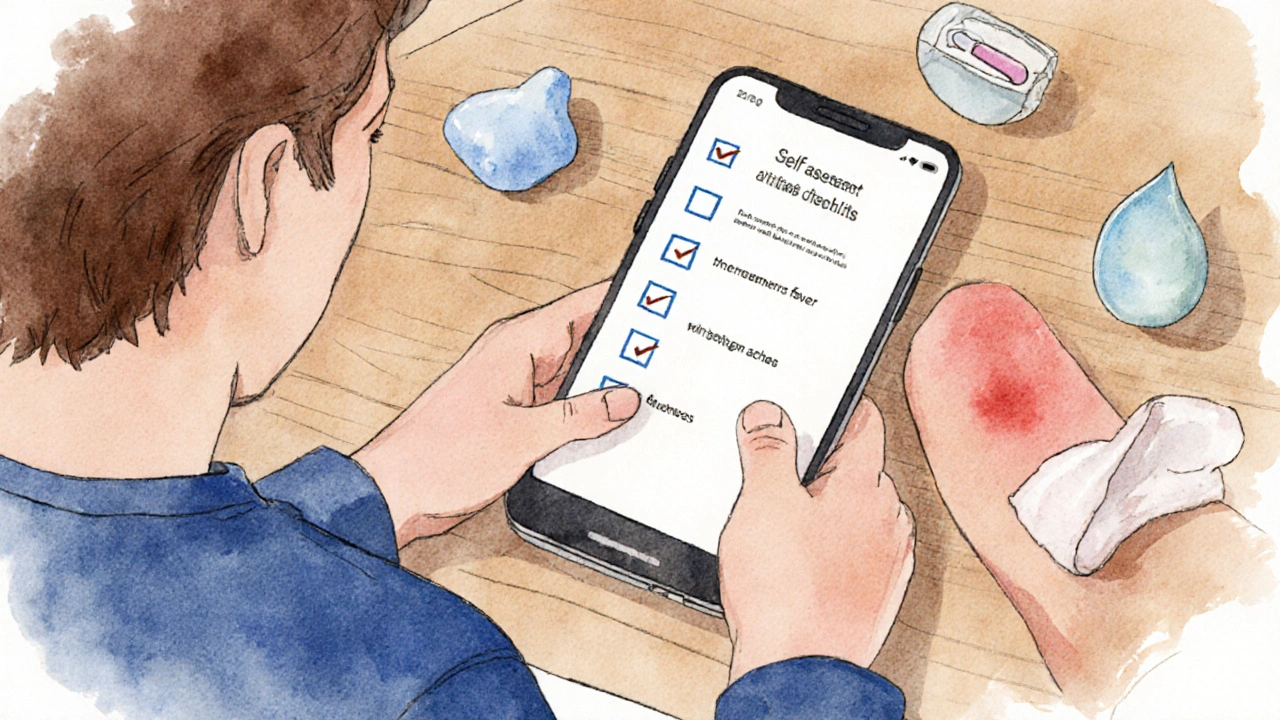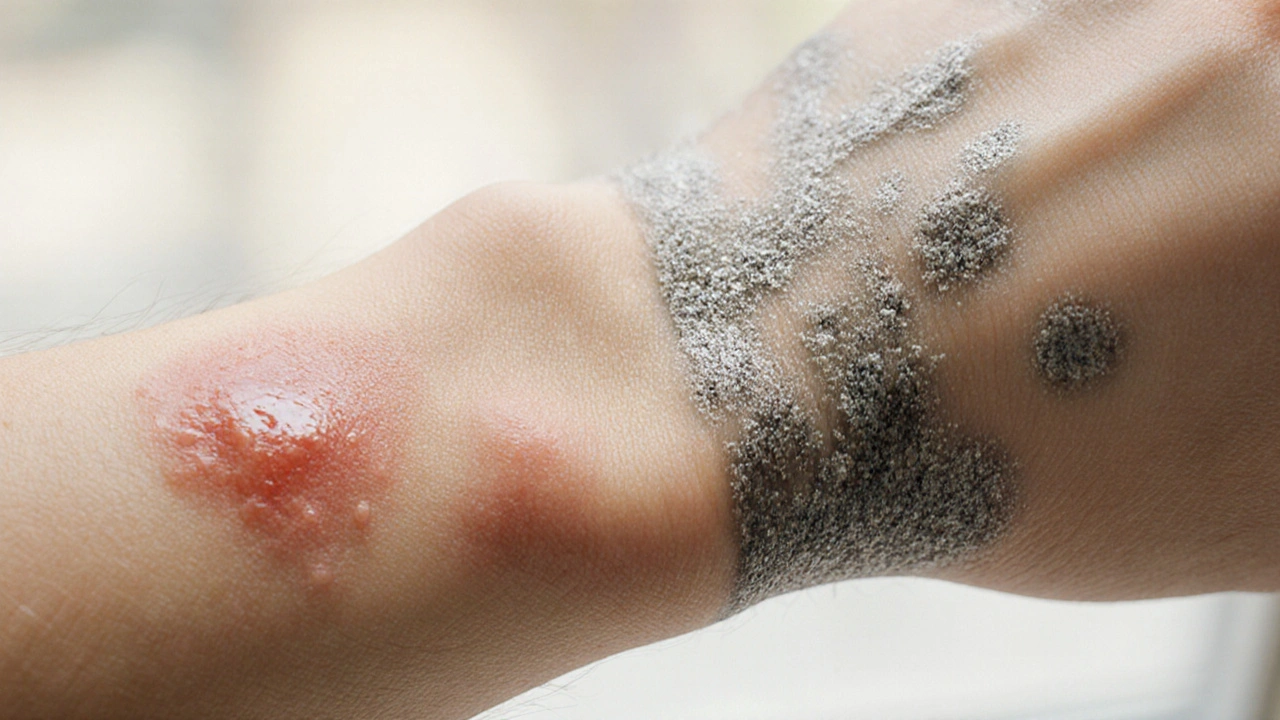Rash vs. Disorder Checker
Ever stared at a red patch on your arm and wondered if it’s just a harmless rash or something more serious? You’re not alone. Knowing the difference can save you weeks of uncertainty and unnecessary trips to the doctor. Below you’ll find a quick cheat‑sheet, step‑by‑step clues, real‑world examples, and a handy table that puts the two side by side. By the end, you’ll be able to make a confident call on whether to treat at home or seek professional help.
TL;DR - Quick Takeaways
- Rashes are usually short‑lived, localized, and triggered by an obvious irritant.
- Disorders persist longer, may spread, and often come with systemic symptoms (fever, itch that won’t quit).
- If the spot is painful, oozing, or changes shape in days, see a dermatologist.
- Track timing, triggers, and accompanying signs-these are your best clues.
- Use the comparison table below for a fast visual check.
What Exactly Is a Skin Rash?
Skin rash is a visible change in the skin’s appearance, often redness, bumps, or irritation caused by an external factor such as an allergen, irritant, or infection. Rashes tend to appear suddenly, stay confined to one area, and disappear once the irritant is removed. Common culprits include poison ivy, a new laundry detergent, or a mild fungal infection. Because the trigger is usually clear, a rash often resolves with simple home care-cool compresses, over‑the‑counter hydrocortisone, or a short course of an antifungal cream.
What Makes a Skin Disorder Different?
Skin disorder is a chronic or systemic condition that alters skin structure or function, frequently involving genetic, autoimmune, or long‑term inflammatory processes. Unlike a fleeting rash, disorders such as eczema, psoriasis, or dermatitis can linger for months or years, flare up repeatedly, and sometimes signal deeper health issues. They often require prescription‑strength medication, lifestyle adjustments, and ongoing monitoring by a dermatologist.
Key Signs That Point Toward a Disorder
When you’re staring at a spot, ask yourself these questions:
- Duration: Has it been more than a week? Rashes usually calm down within a few days; lasting longer suggests a disorder.
- Spread: Is it staying put or crawling across your skin? A rash stays localized; a disorder can expand or appear in multiple zones.
- Systemic clues: Do you have fever, fatigue, or joint pain? Those extra signals hint at an underlying condition.
- Texture: Is the skin scaly, thickened, or cracked? Rashes are often smooth or bumpy; disorders may cause scaling or plaques.
- Response to treatment: Does a cheap cream help? No improvement after a few days of OTC therapy is a red flag.
Answering “yes” to several of these points means you’re likely looking at a disorder rather than a simple rash.

Common Culprits: When Rashes Mimic Disorders
Sometimes the line blurs. Here are three frequent offenders that can confuse anyone:
- Eczema (atopic dermatitis) is a chronic, inflammatory skin disorder that causes itchy, red patches, often triggered by allergens or stress. Early‑stage eczema can look like a rash, but its persistent itch and tendency to recur set it apart.
- Psoriasis is an autoimmune disease that speeds up skin cell turnover, forming thick, silvery scales. A sudden flare may masquerade as a rash, yet the plaques are typically well‑defined and non‑painful.
- Fungal infection (like athlete’s foot) often starts as a small red spot, then spreads with itching and a “ring‑shaped” border. If untreated, it can look like a chronic rash.
Understanding these overlaps helps you avoid mislabeling a disorder as a fleeting irritation.
How to Self‑Assess: A Simple Checklist
Grab a pen or your phone and run through this quick checklist whenever you notice a new skin change.
| Feature | Typical Rash | Typical Disorder |
|---|---|---|
| Onset | Sudden, within hours | Gradual or triggered by flare‑up cycle |
| Duration | Days to a week | Weeks to years |
| Spread | Localized | Can become widespread |
| Systemic symptoms | Rare | Possible (fever, fatigue) |
| Skin texture | Red, smooth or bumpy | Scaly, thickened, or plaque‑like |
| Response to OTC | Improves quickly | Little to no change |
If you tick more boxes under the “Disorder” column, it’s time to book an appointment.
When to Call a Dermatologist
Even the best self‑assessment has limits. Here are the situations where professional help is a no‑brainer:
- Symptoms persist longer than 10 days despite home treatment.
- Rapid spreading, especially to the face, genitals, or hands.
- Severe pain, swelling, or pus formation.
- Accompanying fever, chills, or joint pain.
- History of chronic skin conditions (e.g., eczema, psoriasis) that suddenly change in appearance.
Dermatologists can run a skin biopsy, allergy testing, or prescribe targeted therapies that you won’t find over the counter.
DIY Care Tips While You Wait
If you’re stuck in the “maybe rash, maybe disorder” zone, these home steps can keep things comfortable without masking serious signs:
- Cool compresses for 10‑15 minutes, several times a day, to reduce redness.
- Switch to fragrance‑free soaps and moisturizers.
- Avoid scratching-use a cold pack or anti‑itch cream if needed.
- Keep the area clean and dry; moisture fuels fungal growth.
- Document the spot with a photo each day. Visual trends help doctors decide fast.
These measures won’t cure a deep‑seated disorder, but they’ll ease irritation and prevent secondary infection.
Frequently Asked Questions
Can a rash turn into a disorder?
A rash itself doesn’t become a disorder, but an untreated rash can lead to infection or trigger an underlying condition to flare. That’s why persistent or worsening symptoms deserve a professional eye.
Is itching always a sign of a disorder?
Itching is common in both rashes and disorders. The key is intensity and duration. A mild itch that fades with a cooling pad usually points to a rash; an unrelenting itch that disrupts sleep often signals eczema, psoriasis, or another chronic condition.
Should I use steroid creams for any red patch?
Topical steroids are great for inflammation but can worsen fungal infections or thin the skin if overused. If you’re unsure about the cause, start with a gentle moisturizer and wait 48 hours before reaching for steroids.
What role do allergies play in skin rashes?
Allergies are a leading trigger for acute rashes-think poison ivy, latex, or new cosmetics. If you notice a pattern (e.g., rash after using a specific soap), patch testing by a dermatologist can pinpoint the allergen.
Can stress cause a skin disorder?
Yes. Stress releases cortisol, which can flare eczema, psoriasis, and even trigger new rashes. Managing stress through exercise, meditation, or therapy often improves skin outcomes.
Bottom line: a quick look at timing, spread, and extra symptoms can usually tell you whether you’re dealing with a temporary rash or a deeper skin disorder. When in doubt, err on the side of seeing a dermatologist-your skin will thank you.

Vintage Ireland
I've seen too many people dismiss a lingering rash as just a dry patch, and then it ends up being something serious. It's easy to ignore the little warning signs, especially when life gets busy. If a spot sticks around for more than a week, spreads, or comes with fever, that’s a red flag. Trust your gut and book that dermatologist appointment before it gets worse. Taking care of your skin early saves a lot of hassle later.
Anshul Gupta
Seriously, a quiz? That’s the best you could do.
John Vallee
Reading through the checklist felt like a mini‑medical exam, and I couldn't help but nod at each warning sign.
The first question about duration reminded me of the countless times I've ignored a rash because it seemed 'just a week' and hoped it would disappear.
When the tool flagged the spread question, I realized how quickly my own elbow rash had migrated to my forearm during a recent hike.
Systemic symptoms like a low‑grade fever are often the body’s way of shouting that something deeper is brewing.
The texture query hit home when I remembered the scaly patches on my knees after a dry winter.
I also appreciated the OTC treatment question, since I've tried a dozen creams that promised miracle cures.
Adding up the points felt like tallying a courtroom case, each piece of evidence nudging the verdict closer to 'disorder'.
What struck me most was how the score threshold of three wasn't arbitrary; it aligns with clinical guidelines for when a dermatologist should be consulted.
Moreover, the interactive design makes the whole process less intimidating than flipping through a medical textbook.
I shared the results with a friend who had a similar rash, and we both decided to schedule appointments rather than scroll through endless forums.
The tool also subtly educates readers about the importance of systemic clues, which are often overlooked by DIY skin blogs.
In my experience, early detection can prevent chronic conditions that require extensive treatment later on.
While no online quiz can replace a professional diagnosis, this one serves as a solid first step toward responsible self‑care.
The clear visual feedback-green for rash, red for disorder-helps users grasp the seriousness at a glance.
I’d recommend coupling this with a quick photo diary to track any changes before seeing the doctor.
All in all, it's a handy triage assistant that empowers you to take your skin health seriously without panicking.
Brian Davis
From a linguistic perspective, the questionnaire uses clear binary options, which reduces ambiguity for non‑native speakers. It's also helpful that each question is phrased in simple present tense, avoiding complex medical jargon that could confuse readers. The inclusion of terms like 'systemic symptoms' might still be a bit technical, but the context makes it understandable. Also, the layout respects left‑to‑right reading order, which aligns with most Western languages. Overall, the design is user‑friendly and culturally neutral, making it accessible worldwide.
jenni williams
hey, i totally get how freaky a weird spot can be 😟. if it’s been hanging around for more than a week and you’re feeling kinda off, trust that gut feeling. a quick visit to a skin doc can save you lots of stress later. don’t wait ‘til it gets worse, ok? stay safe!
Kevin Galligan
Right, because everyone has a dermatologist on speed‑dial, huh? But seriously, a quick lookup can be a lifesaver before the rash turns into a full‑blown drama. 👍
Dileep Jha
While the heuristic scoring is intuitive, it oversimplifies the pathophysiology of dermatologic presentations. A binary rubric neglects the nuanced etiological spectrum-autoimmune, infectious, iatrogenic-each demanding distinct diagnostic algorithms.
Michael Dennis
The analysis is adequate, though it could benefit from a more rigorous statistical validation. As presented, the tool remains a heuristic rather than a substantiated clinical instrument.